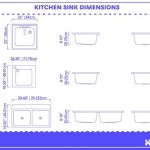Kitchen Sink Leaking Around Edges
A leaking kitchen sink is a common problem that can be caused by a variety of factors. In most cases, the leak is relatively easy to fix, but it is important to identify the source of the leak before attempting repairs. One of the most common causes of a kitchen sink leaking around the edges is a worn-out or damaged gasket. The gasket is a rubber or plastic seal that sits between the sink and the countertop, and it is designed to prevent water from leaking out. Over time, the gasket can become worn or damaged, which can allow water to leak out around the edges of the sink.
Another common cause of a kitchen sink leaking around the edges is a loose or damaged drainpipe. The drainpipe is the pipe that carries water from the sink to the drain. If the drainpipe is loose or damaged, it can allow water to leak out around the edges of the sink. In some cases, the leak may be caused by a crack or hole in the sink itself. This is more likely to occur in older sinks that are made of materials such as cast iron or porcelain.
If you notice that your kitchen sink is leaking around the edges, it is important to identify the source of the leak before attempting repairs. Once you have identified the source of the leak, you can follow these steps to fix it:
- If the leak is caused by a worn-out or damaged gasket, you will need to replace the gasket. To do this, first turn off the water supply to the sink. Then, use a putty knife or a flat-head screwdriver to remove the old gasket. Once the old gasket is removed, clean the surface of the sink and the countertop where the gasket will be installed. Apply a thin bead of silicone sealant to the surface of the sink and the countertop, and then install the new gasket. Allow the silicone sealant to dry completely before turning the water supply back on.
- If the leak is caused by a loose or damaged drainpipe, you will need to tighten or replace the drainpipe. To do this, first turn off the water supply to the sink. Then, use a wrench to tighten the nuts that hold the drainpipe in place. If the drainpipe is damaged, you will need to replace it. To do this, first remove the old drainpipe by unscrewing the nuts that hold it in place. Then, install the new drainpipe and tighten the nuts.
- If the leak is caused by a crack or hole in the sink, you will need to repair or replace the sink. To repair a crack or hole in a sink, you can use a two-part epoxy adhesive. To do this, first clean the surface of the sink around the crack or hole. Then, mix the two parts of the epoxy adhesive according to the manufacturer's instructions. Apply the epoxy adhesive to the crack or hole, and allow it to dry completely.
If you are not comfortable making these repairs yourself, you can hire a plumber to do them for you. Plumbers have the experience and expertise to quickly and easily fix a leaking kitchen sink.

Why The Edges Of Kitchen Sink Leak Mr Rooter

Magic Tape To Fix Leaking Sinks How Seal Kitchen Sink Edges W Caulking

How Do I Fix Up The Kitchen Sink Edge Bunnings Work Community

Kitchen Sink Side Leak How To Solving Option I Love God Youtube

How To Fix Fallen Undermount Sink Under Granite Countertop Diy 2024

Granite Kitchen Sink Leaking Underneath Youtube

Easy How To Replace The Silicone On An Undercounter Sink Youtube

How To Repair Mouldy Sealant Around Your Kitchen Sink Recommend My

How To Seal A Kitchen Faucet Youtube

How To Silicone Mastic Around A Sink Youtube







